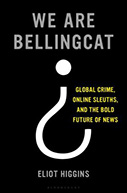We Are Bellingcat: Global Crime, Online Sleuths, and the Bold Future of News

Author: Eliot Higgins
Publisher: Bloomsbury USA, 2021. 272 pages.
Reviewers: Britta H. Crandall and Russell Crandall ǀ March 2022
During the 1990s, British intelligence agents recruited Sergei Skripal, a Russian intelligence officer, to become a double agent. Moscow eventually caught on to his ways, sentencing the traitor to thirteen years in 2004. However, as part of a U.S.-Russia spy swap in 2010, Skirpal was sent west, landing in the bucolic city of Salisbury, England after the British government insisted he be included in the exchange.
It was in Salisbury where on March 4, 2018, Skripal, then 66, and his daughter Yulia, 33, were discovered close to death hunched over a public bench. All eyes were on Moscow. Back in 2006, Alexander Litvinenko, a Russian spy who had defected to Great Britain where he was a strident critic of Russian head of state Vladimir Putin, was suspiciously poisoned (and killed). Russian authorities denied any culpability in what some called the “revenge poisoning” episode.
Over the months in which Sergei and Yulia were slowing recovering, both London and Washington expelled dozens of Russian “diplomats,” with Moscow responding in kind. British authorities caught a break in their investigation of the case when they learned about a man who discovered what appeared to be a full bottle of Nina Ricci “Premier Jour” fragrance when searching through a garbage dumpster in Salisbury. He gave it to his girlfriend, who after applying it on her wrists, immediately manifested a mysterious illness which ended up killing her. A silver lining in the tragedy was that the authorities identified the poison as Novichok, a circa 1970s and 1980s Soviet Union-developed lethal nerve agent, developed at the very time that Putin was an officer in the KGB.
It took another six months for the next development. British police released images of two burly Russian men at Gatwick Airport, just days prior to the episode. The two mystery men then traveled, on consecutive days, to Salisbury. The Kremlin justified the pair’s visit as tourism-related – a desire to see the city “famous for its 123-metre spire,” and the case once again hit a lull.
Here is when the story gets interesting. A non-governmental investigative “cooperative” known as “Bellingcat” began following the case. On an internal chat board, volunteers and analysts howled at the Russians’ joke of a response. “’Famous for its 123-metre spire’ Who spoke like that, as if reciting a Wikipedia entry.” For Bellingcat’s founder, Eliot Higgins, if British officials could not get to the bottom of this cold case, his team of citizens/journalists would. Impossibly, it took Bellingcat only a matter of days before it identified the two men as a “war-hardened GRU (Russian military intelligence)” agent Anatoly Chepiga, and a military doctor, Alexander Mishkin. In fact, while it was at it, Bellingcat unmasked a “Third Man,” an additional member of Putin’s hit team.
Global headlines abounded: what and who exactly was this motley mix of amateur internet sleuths calling itself “Bellingcat” that cracked the Russian nerve agent case? As we learn in his riveting half-memoir, half-digital world cri de cœur, We are Bellingcat, Eliot Higgins was the man behind the scenes – a college drop-out who founded the organization a decade prior when he was just a computer geek with a boring day job. His eureka realization was that society no longer relied on experts or the media to find information online. As time progressed, this simple insight developed into an “online collective” (initially 18 staff with scores of volunteers, across the globe) who crowd-sourced and patched together research or investigative “hacks.” All told, his emerging methodology which he calls “online open-source investigation” brought together the trifecta of journalism, crime investigation, and rights activism and advocacy. The author provides the group’s mojo: “We have no agenda, but we do have a credo: evidence exists and falsehoods exist, and people still care about the difference.”
Higgins’ success relies on the fact that just a generation or two ago, 90 percent of valuable information was secret, while today the ratio is flipped. Indeed, it is all right in front of our faces—or, really, our screens. All it takes is a group of minds to connect all the dots, “picking apart disinformation” as they go along. Interestingly, this digital, citizen-driven investigative revolution is happening while myriad governmental spy agencies spend billions of dollars on the gargantuan industry of covert intelligence gathering and analysis. Make no mistake, intelligence outfits did use open sources from newspapers to radio to public documents. But, when compared to the value placed on covert materials writ large, this was a side-show compared to the orthodox emphasis on classified sources.
While the author doesn’t get into this issue, Bellingcat’s success leads us to wonder if governments need to spend billions on intelligence when so much equally or more valuable information is free online. The author does raise the episode of the George W. Bush administration’s justification for the 2003 invasion of Iraq as based on classified intelligence, which of course proved to be almost entirely debunked afterwards.
A reader would surely wonder about Bellingcat’s methodology. It turns out that the secret sauce is a range of tools. It might be software or an app that can date an image. Or it could be data or insights gleaned from gratis satellite maps or leaked data bases, whatever the worldwide web would spit out. The novel but nonetheless work-a-day “Bellingcat way,” led to a number of remarkable confirmations concerning a wide array of topics: the whereabouts of pro-ISIS agents in Europe; the Syrian government’s use of chemical weapons against its own people; the identities of those who hatched the plot to down Malaysian Airlines Flight 17 over Ukraine in 2014; rampaging neo-Confederates in Charlottesville, Virginia in 2017; and disinformation related to the Covid-19 epidemic. Given this exceptional track-record, Higgins can be forgiven when he boasts that the Bellingcat team of a couple of dozen full-time employees produce reports read by hundreds of thousands, including state intelligence agencies.
Paradoxically, while facts are more available than ever, equally powerful is the current age of online disinformation. For this reason, Higgins urges us to resist the force pulling “truth” towards an element of group identity or one’s own political or social tribe. Bellingcat holds facts and truth in the highest esteem, which is by definition anti-autocrat. If George Orwell could read this book, he would perhaps first grimace at the lies described, but beam at the courage of these citizen journalists and citizen crime sleuths—many of whom are probably facing their computer screens as you read this review.
Britta Crandall, Visiting Assistant Professor of Latin American Studies at Davidson College
Russell Crandall, Professor of Latin American Studies at Davidson College


